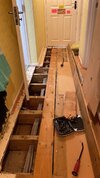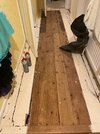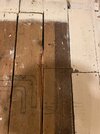House built mid 1950s. We had a leak under the shower with water running into the ceiling (https://www.diynot.com/diy/threads/shower-leak-and-floor-damage.640390/#post-5894893) and I had to rip the landing carpet up and lift some floorboards - we weren't sure whether it was a leaking pipe, thankfully not.
The floorboards have seen better days and I'm tempted to replace them as I've already got the carpet up. That way I know it's done and won't need to be touched again while we're in the house.
Most floor boards seem to be 18mm these days, mine are just over 20. Am I right in thinking that these (https://www.travisperkins.co.uk/pla...ing-5th-finished-size-20-5mm-x-144mm/p/181003) - finished size 20.5 mm would be the right replacements?
The floorboards have seen better days and I'm tempted to replace them as I've already got the carpet up. That way I know it's done and won't need to be touched again while we're in the house.
Most floor boards seem to be 18mm these days, mine are just over 20. Am I right in thinking that these (https://www.travisperkins.co.uk/pla...ing-5th-finished-size-20-5mm-x-144mm/p/181003) - finished size 20.5 mm would be the right replacements?




